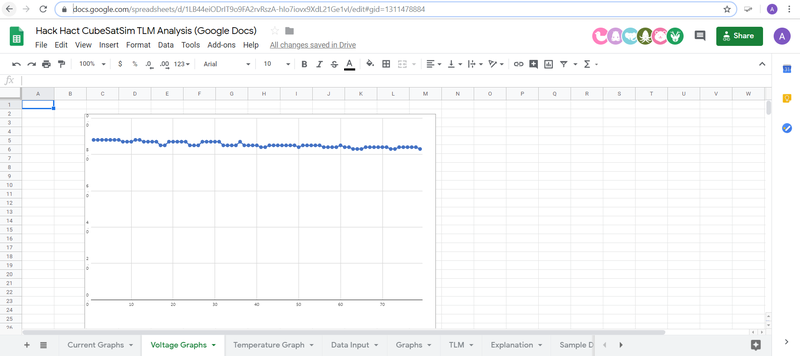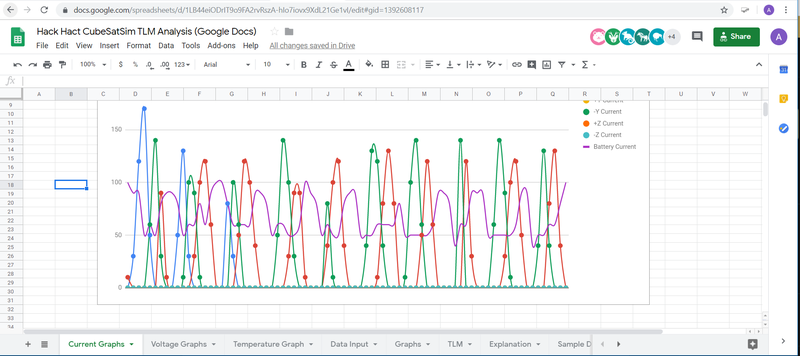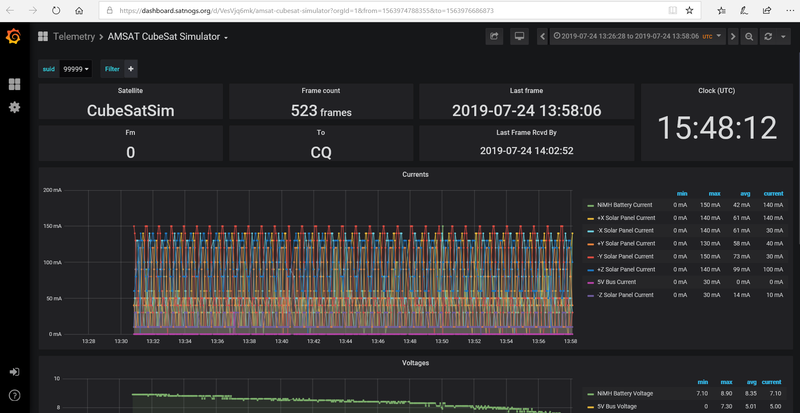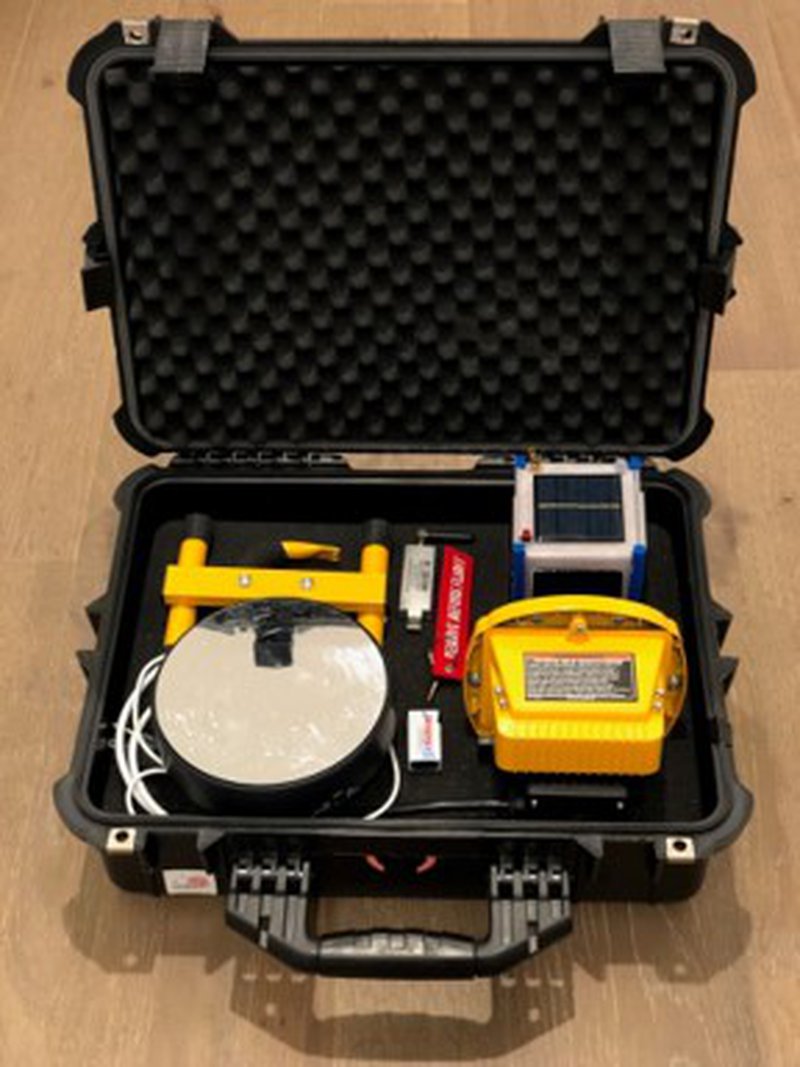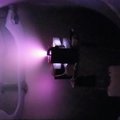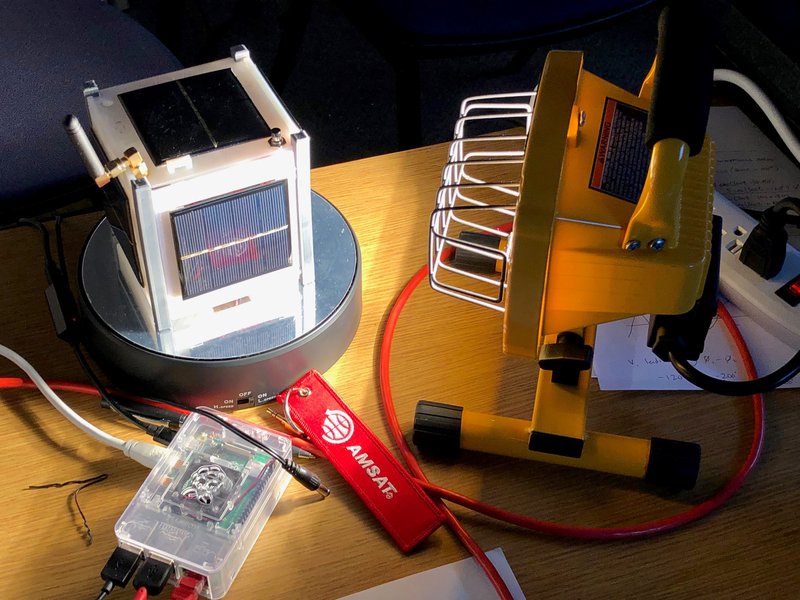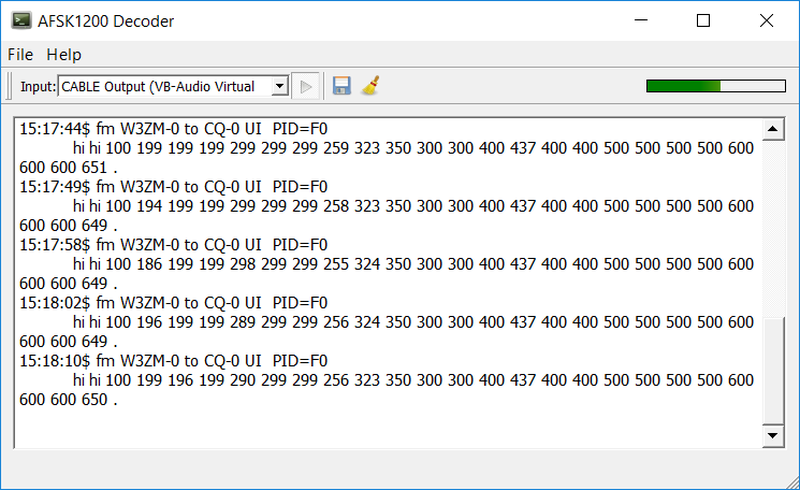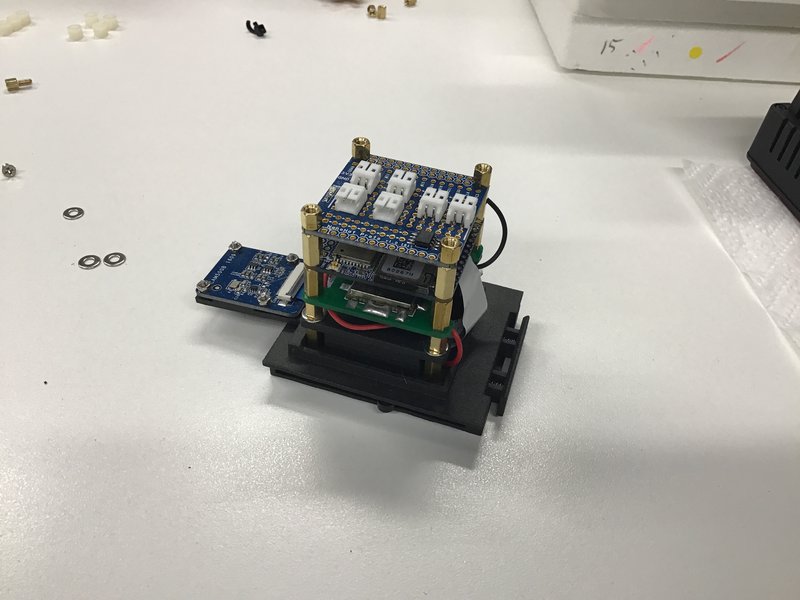-
Hack Chat Transcript, Part 2
12/04/2019 at 21:04 • 0 comments![]() FSK is a Fox-1 emulation mode, also known as Data Under Voice or DUV
FSK is a Fox-1 emulation mode, also known as Data Under Voice or DUV![]() The BPSK mode is for Fox-1E (to be launched in 2020) and HuskySat-1 1200 bps
The BPSK mode is for Fox-1E (to be launched in 2020) and HuskySat-1 1200 bps![]() ah yeh can see the frequency jump now
ah yeh can see the frequency jump now![]() (must be lagging a tad)
(must be lagging a tad)![]() This LoRa FossaSat-1 will be interesting.
This LoRa FossaSat-1 will be interesting.![]() not to talk about another satellite ;)
not to talk about another satellite ;)![]() Here's the waterfall with the 3 different modes
Here's the waterfall with the 3 different modes![]() i am looking forward to FossaSat-1 more than you know :)
i am looking forward to FossaSat-1 more than you know :)![]()
![]() @steve.bossert - me too!
@steve.bossert - me too!![]() Yes, LoRA is cool!
Yes, LoRA is cool!![]() I have my 1 watt LoRa radio waiting for it ... with a Yagi ;)
I have my 1 watt LoRa radio waiting for it ... with a Yagi ;)![]() @alan.b.johnston - how did you go about building out the ground station you are using?
@alan.b.johnston - how did you go about building out the ground station you are using?![]() An SDR I feed into spyserver is set to default to 911.25 Mhz and let others near my experiment with decoding Lora and other bursts down in 70cm.... back on subject now :) I would be interested to see the sim run Lora if possible (not today, some other time)
An SDR I feed into spyserver is set to default to 911.25 Mhz and let others near my experiment with decoding Lora and other bursts down in 70cm.... back on subject now :) I would be interested to see the sim run Lora if possible (not today, some other time)![]() My Web SDR ground station is an old Ubuntu laptop, running openwebrx with an RTL-SDR plugged into it
My Web SDR ground station is an old Ubuntu laptop, running openwebrx with an RTL-SDR plugged into it![]() antenna alan?
antenna alan?![]() What is good about LoRa FossaSat-1? (first I've heard of it)
What is good about LoRa FossaSat-1? (first I've heard of it)![]() I use remote.it to open a port to 7300 so that it is accessible outside my network, just while I do this demo
I use remote.it to open a port to 7300 so that it is accessible outside my network, just while I do this demo![]() My antenna for this demo is just a rubber duck!
My antenna for this demo is just a rubber duck!![]() I also have a tape measure Yagi hanging out my office window
I also have a tape measure Yagi hanging out my office window![]() I'm helping the CubeSat Club members here build a Lindenblad - it is almost finished!
I'm helping the CubeSat Club members here build a Lindenblad - it is almost finished!![]() i bet your sim could also be helpful for those looking to test payloads for balloons.
i bet your sim could also be helpful for those looking to test payloads for balloons.![]() LoRA modulation is spread spectrum, so requires radically lower power levels or simpler ground stations. Could be a game changer for future satellite low bit rate communication
LoRA modulation is spread spectrum, so requires radically lower power levels or simpler ground stations. Could be a game changer for future satellite low bit rate communication![]() Yes, it could be used with balloons.
Yes, it could be used with balloons.![]() Ah I see
Ah I see![]() If you look at the Voltage tab on this graph https://docs.google.com/spreadsheets/d/1LB44eiODrIT9o9FA2rvRszA-hIo7iovx9XdL21Ge1vI/edit#gid=1311478884 you can see how the voltage dropped before
If you look at the Voltage tab on this graph https://docs.google.com/spreadsheets/d/1LB44eiODrIT9o9FA2rvRszA-hIo7iovx9XdL21Ge1vI/edit#gid=1311478884 you can see how the voltage dropped before![]() When it went below 8V, the Pi automatically shut down
When it went below 8V, the Pi automatically shut down![]() Here's a screenshot of the voltage telemetry from before
Here's a screenshot of the voltage telemetry from before![]()
![]() Here's the current graphs
Here's the current graphs![]() 8V... is there a regulator there dropping below 5v?
8V... is there a regulator there dropping below 5v?![]()
![]() Anyone receiving the satellite? ;-)
Anyone receiving the satellite? ;-)![]() (probs a daft question I only wondered since I have my zero on a 5v usb
(probs a daft question I only wondered since I have my zero on a 5v usb![]() Yes, I use a 9V NiMH battery
Yes, I use a 9V NiMH battery![]() So it isn't good to discharge it all the way down to 5V
So it isn't good to discharge it all the way down to 5V![]() ah gotcha
ah gotcha![]() I have a battery charging board made by MoPower that handles the charging
I have a battery charging board made by MoPower that handles the charging![]() So AMSAT has built 4 loaners that can be shipped to a classroom anywhere
So AMSAT has built 4 loaners that can be shipped to a classroom anywhere![]() Not seeing the sat via the proxy. Keep getting a timeout.
Not seeing the sat via the proxy. Keep getting a timeout.![]() Message me offline if you are a teacher or know a teacher who would like to show it off in the classroom
Message me offline if you are a teacher or know a teacher who would like to show it off in the classroom![]() Hello
Hello![]() Here's the web sdr link http://proxy22.rt3.io:38006
Here's the web sdr link http://proxy22.rt3.io:38006![]() Make sure it isn't trying https - that won't work!
Make sure it isn't trying https - that won't work!![]() Oh, and SatNOGS has a Dashboard for the Simulator, too! :-)
Oh, and SatNOGS has a Dashboard for the Simulator, too! :-)![]() I need help
I need help![]() SatNOGS Dashboard: https://dashboard.satnogs.org/d/VesVjq6mk/amsat-cubesat-simulator?orgId=1&from=1563974788355&to=1563976686873
SatNOGS Dashboard: https://dashboard.satnogs.org/d/VesVjq6mk/amsat-cubesat-simulator?orgId=1&from=1563974788355&to=1563976686873![]() The satellite is back, and now back on the right frequency again! 434.9 MHz
The satellite is back, and now back on the right frequency again! 434.9 MHz![]() I'd definitely like to do something like that (build or demo one in the future) but defo need to learn more about it myself first. Need a bit more time with the Cube Sat Sim for starters. I've not tried the decoding yet.
I'd definitely like to do something like that (build or demo one in the future) but defo need to learn more about it myself first. Need a bit more time with the Cube Sat Sim for starters. I've not tried the decoding yet.![]() Nope, now it drifted again!
Nope, now it drifted again!![]() Good to log Voltage against temperature/baro. There was some wacky telemetry with USMA West Point and the past two balloons sent up. At 98k feet, it got pretty cold (and wet) and affected the battery on one of the transmitters. lessons learned to send up two transmitters for redundancy. testing via balloon before going into orbit is good live test too. your doing some great work Alan. will message you offline.
Good to log Voltage against temperature/baro. There was some wacky telemetry with USMA West Point and the past two balloons sent up. At 98k feet, it got pretty cold (and wet) and affected the battery on one of the transmitters. lessons learned to send up two transmitters for redundancy. testing via balloon before going into orbit is good live test too. your doing some great work Alan. will message you offline.![]() Sure, give it a try! I have a lot of fun with it
Sure, give it a try! I have a lot of fun with it![]() Very good points, Steve. Thanks!
Very good points, Steve. Thanks!![]() what are the bare minimum electronic components required to build a very simple satellite apart from what I mention here 1) Arduino 2) Rechargable battery circuit 3) battery 4) solar panels?
what are the bare minimum electronic components required to build a very simple satellite apart from what I mention here 1) Arduino 2) Rechargable battery circuit 3) battery 4) solar panels?![]() Here's the SatNOGS Dashboard for the Simulator
Here's the SatNOGS Dashboard for the Simulator![]()
![]() J: We are using the 70cm band in the 430-440MHz range for high altitude balloon. Getting some very impressive results with it. A wire antenna @ 100mW can reach low earth orbit easily. Although who knows how much noise you will be competing with up in space. I can hit one of our 401MHz satellites with tens of milliwatts using BPSK and a whip antenna, so its certainly very possible.
J: We are using the 70cm band in the 430-440MHz range for high altitude balloon. Getting some very impressive results with it. A wire antenna @ 100mW can reach low earth orbit easily. Although who knows how much noise you will be competing with up in space. I can hit one of our 401MHz satellites with tens of milliwatts using BPSK and a whip antenna, so its certainly very possible.![]() @chinna, you need a radio system to relay data back or at least present a beacon.
@chinna, you need a radio system to relay data back or at least present a beacon.![]() @Chinna That's about it. And a rocket :-)
@Chinna That's about it. And a rocket :-)![]() steve bossert: what radios did you guys send up in the balloons that did that?
steve bossert: what radios did you guys send up in the balloons that did that?![]() Chinna: one key thing is that you need to have two way telemetry and a way to change frequency, if need be.
Chinna: one key thing is that you need to have two way telemetry and a way to change frequency, if need be.![]() Hi @Joe and @Alan, what is the simplest telemetry thing I can have?
Hi @Joe and @Alan, what is the simplest telemetry thing I can have?![]() any pointers?
any pointers?![]() @Chinna use a LoRa radio or HamShield
@Chinna use a LoRa radio or HamShield![]() Chinna when I was looking into this there was a lot of info on the web page I think where I found the cubesatsim stuff
Chinna when I was looking into this there was a lot of info on the web page I think where I found the cubesatsim stuff![]() @Casey Halverson some sort of generic module. will have to get back to you . (your the hamsheild team?, thats what may have been better)
@Casey Halverson some sort of generic module. will have to get back to you . (your the hamsheild team?, thats what may have been better)![]() @steve.bossert Yes, thats me. :)
@steve.bossert Yes, thats me. :)![]() @Chinna, I am using a DRU818U radio that is programmed via Python on a NanoPi processor board.
@Chinna, I am using a DRU818U radio that is programmed via Python on a NanoPi processor board.![]() Here's what the loaner units look like - self contained
Here's what the loaner units look like - self contained![]()
![]()
![]() @steve.bossert the HamShield Mini is a small 200mW triband transceiver .. we also have a 1 watt LoRa version for 440MHz. Launching 144MHz and 915MHz LoRa shields next week. Although those will do 500mW.
@steve.bossert the HamShield Mini is a small 200mW triband transceiver .. we also have a 1 watt LoRa version for 440MHz. Launching 144MHz and 915MHz LoRa shields next week. Although those will do 500mW.![]() @alan.b.johnston, NICE setup!
@alan.b.johnston, NICE setup!![]() @alan.b.johnston thats impressive.
@alan.b.johnston thats impressive.![]() @Casey Halverson i just took advantage of some black friday sales at inductive twig for hamshield and other stuff.
@Casey Halverson i just took advantage of some black friday sales at inductive twig for hamshield and other stuff.![]() Thanks! It has been in about a half dozen high schools and about a dozen universities so far.
Thanks! It has been in about a half dozen high schools and about a dozen universities so far.![]() @alan.b.johnston do you have a schedule for any upcoming school demo you are doing?
@alan.b.johnston do you have a schedule for any upcoming school demo you are doing?![]() @alan.b.johnston Yeah, thats very portable for that kind of thing.
@alan.b.johnston Yeah, thats very portable for that kind of thing.![]() Frequency just changed again. I wish I knew why rpitx does that sometimes!
Frequency just changed again. I wish I knew why rpitx does that sometimes!![]() Out of interest, are you instructing it to change frequencies? or is that part of the protocol?
Out of interest, are you instructing it to change frequencies? or is that part of the protocol?![]() @Joe, thanks for letting me know your radio
@Joe, thanks for letting me know your radio![]() @steve.bossert I don't have any scheduled right now
@steve.bossert I don't have any scheduled right now![]() @steve.bossert I packed your NanoVNA in fact. I knew your name sounded familiar.
@steve.bossert I packed your NanoVNA in fact. I knew your name sounded familiar.![]() Some frequencies by their design are required to change when interference is detected. For instance, Wifi-N jumps off its current channel if Police are nearby using Speed radar :P
Some frequencies by their design are required to change when interference is detected. For instance, Wifi-N jumps off its current channel if Police are nearby using Speed radar :P![]() @J I am not doing that intentionally! The rpitx library is jumping around for some reason
@J I am not doing that intentionally! The rpitx library is jumping around for some reason![]() oh (question answered - had chat lag)
oh (question answered - had chat lag)![]() I'm going to key up with my HT one last time ;-)
I'm going to key up with my HT one last time ;-)![]() I keyed up on 434.85 MHz this time
I keyed up on 434.85 MHz this time![]() Fantastic Alan! Thanks for sharing! Great conversation!
Fantastic Alan! Thanks for sharing! Great conversation!![]() Yes thanks for the chat and demo!
Yes thanks for the chat and demo!![]() Thanks! This has been fun. I hope some of you will build one!
Thanks! This has been fun. I hope some of you will build one!![]() If you do, send me pix!
If you do, send me pix!![]() It is exciting that satellites are in such close reach.
It is exciting that satellites are in such close reach.![]() Will be building one.
Will be building one.![]() I think i am going to build one.
I think i am going to build one.![]() One last question, does having GPS sensor on board is of any use?
One last question, does having GPS sensor on board is of any use?![]() Well, it would work if you had it near a window
Well, it would work if you had it near a window![]() Well a build might be a way off yet but certainly seeing this today has reminded me to have another go at getting decoding going with the cubesatsim
Well a build might be a way off yet but certainly seeing this today has reminded me to have another go at getting decoding going with the cubesatsim![]() Since it doesn't fly around, it would always give the same location, but we have done it before
Since it doesn't fly around, it would always give the same location, but we have done it before![]() @Chinna I think even the UBlox in flight mode might have trouble in LEO. Could be wrong.
@Chinna I think even the UBlox in flight mode might have trouble in LEO. Could be wrong.![]() I gues a GPS might be fun if one was going to take it out and about
I gues a GPS might be fun if one was going to take it out and about![]() For GPS in LEO you need an unregulated version. They are not cheap and have a lot of export controls.
For GPS in LEO you need an unregulated version. They are not cheap and have a lot of export controls.![]() The FossaSat people literally made the exterior out of PCB and trisolx solar panels SMT'ed.. i thought that was interesting.
The FossaSat people literally made the exterior out of PCB and trisolx solar panels SMT'ed.. i thought that was interesting.![]() @alan, would GPS will be of any use in the case of baloon experiment?
@alan, would GPS will be of any use in the case of baloon experiment?![]() The telemetry spreadsheet will be available after this chat is over https://docs.google.com/spreadsheets/d/1LB44eiODrIT9o9FA2rvRszA-hIo7iovx9XdL21Ge1vI/edit?usp=sharing
The telemetry spreadsheet will be available after this chat is over https://docs.google.com/spreadsheets/d/1LB44eiODrIT9o9FA2rvRszA-hIo7iovx9XdL21Ge1vI/edit?usp=sharing![]() But the web sdr won't!
But the web sdr won't!![]() So we're coming up on the top of the hour, which is when we normally let hosts go in case they have to get back to work. Of course the Hack Chat is always open, so please feel free to continue the discussion as long as @alan.b.johnston wants to stay on. I want to thank Alan for taking time out today to meet with us - this was really interesting to me, especially seeing how many people are so into CubeSats!
So we're coming up on the top of the hour, which is when we normally let hosts go in case they have to get back to work. Of course the Hack Chat is always open, so please feel free to continue the discussion as long as @alan.b.johnston wants to stay on. I want to thank Alan for taking time out today to meet with us - this was really interesting to me, especially seeing how many people are so into CubeSats!![]() Thanks Alan!
Thanks Alan!![]() Thanks everyone for joining and for the questions!
Thanks everyone for joining and for the questions!![]() And don't forget that we have a related Hack Chat next week - open-source thrusters for nano-satellites with Michael Bretti from @Applied Ion Systems:
And don't forget that we have a related Hack Chat next week - open-source thrusters for nano-satellites with Michael Bretti from @Applied Ion Systems:![]() I do need to run, so 73!
I do need to run, so 73!![]()
Hack Chat Transcript, Part 1 12/04/2019 at 21:03 • 0 comments
Hi everyone!
![]() Hi Alan
Hi Alan![]() You guys don't have audio?
You guys don't have audio?:o)
![]() Hi @alan.b.johnston! We'll kick off in just a minute or two
Hi @alan.b.johnston! We'll kick off in just a minute or two![]() hi alan, looking forward to the chat!
hi alan, looking forward to the chat!![]() Good Afternoon everyone.
Good Afternoon everyone.![]() OK everyone, let's get started! Thanks for your patience with the lack of Hack Chats during the Supercon break. But we're back today with a great one - @alan.b.johnston is here to tell us all about simulations for CubeSats.
OK everyone, let's get started! Thanks for your patience with the lack of Hack Chats during the Supercon break. But we're back today with a great one - @alan.b.johnston is here to tell us all about simulations for CubeSats.Alan - can you tell us a little about your background and how you came to the CubeSat world?
![]() And welcome, BTW!
And welcome, BTW!![]() Thanks, Dan. Sure! Welcome everyone! Thanks for joining
Thanks, Dan. Sure! Welcome everyone! Thanks for joining![]() I got my start in electronics and radio as a teenager when he got his ham radio extra class license, call sign KU2Y. He built satellite antennas, and tracked satellites, and communicated using the AMSAT OSCAR-8 satellite. Since 2018 he has served as AMSAT’s Vice President for Educational Relations. I am also an Associate Teaching Professor of Electrical and Computer Engineering at Villanova, University.
I got my start in electronics and radio as a teenager when he got his ham radio extra class license, call sign KU2Y. He built satellite antennas, and tracked satellites, and communicated using the AMSAT OSCAR-8 satellite. Since 2018 he has served as AMSAT’s Vice President for Educational Relations. I am also an Associate Teaching Professor of Electrical and Computer Engineering at Villanova, University.![]() The AMSAT CubeSat Simulator is a functional model of a satellite for use in education and demonstrations. A proof-of-concept prototype was shown at the 2018 AMSAT Space Symposium, and the CubeSat Simulator program was officially “launched” at the AMSAT Update Forum at Hamvention 2019 in Dayton, OH.
The AMSAT CubeSat Simulator is a functional model of a satellite for use in education and demonstrations. A proof-of-concept prototype was shown at the 2018 AMSAT Space Symposium, and the CubeSat Simulator program was officially “launched” at the AMSAT Update Forum at Hamvention 2019 in Dayton, OH.![]() It is Raspberry Pi Zero W-based, 3D-printed frame structure, functional model of a “1U” CubeSat and is designed to act, as reasonably as possible, as though in Low Earth Orbit (LEO).
It is Raspberry Pi Zero W-based, 3D-printed frame structure, functional model of a “1U” CubeSat and is designed to act, as reasonably as possible, as though in Low Earth Orbit (LEO).![]() Runs on rechargeable “flight” NiMH battery power and body-mounted solar cell panels.
Runs on rechargeable “flight” NiMH battery power and body-mounted solar cell panels.![]() Transmits housekeeping telemetry on the 70 cm band using AO-7 format using AFSK AX.25 modulation
Transmits housekeeping telemetry on the 70 cm band using AO-7 format using AFSK AX.25 modulation![]() Lots of info at http://cubesatsim.org
Lots of info at http://cubesatsim.org![]() I have a live demo running in my office right now
I have a live demo running in my office right now![]() I'll try pasting a photo, see if it works
I'll try pasting a photo, see if it works![]() you need to click the image button first
you need to click the image button first![]() So that's interesting - do flight-qualified CubeSats used NiMH batteries routinely? Guess I always assumed something more "modern" like LiPo
So that's interesting - do flight-qualified CubeSats used NiMH batteries routinely? Guess I always assumed something more "modern" like LiPo![]()
![]()
![]() Lets see if that worked!
Lets see if that worked!![]() Yes, the battery design choice always generates questions :-)
Yes, the battery design choice always generates questions :-)![]() So what battery did you use and what is the total system power usage?
So what battery did you use and what is the total system power usage?![]() Most CubeSats today use LiPO, yes, and they provide much higher capacity than nickel metal hydride
Most CubeSats today use LiPO, yes, and they provide much higher capacity than nickel metal hydride![]() I chose the NiMH for two reasons:
I chose the NiMH for two reasons:![]() 1. The simulator was designed to be easy to ship to classrooms and events. So being able to answer "No" to the LiPO question when shipping is big benefit
1. The simulator was designed to be easy to ship to classrooms and events. So being able to answer "No" to the LiPO question when shipping is big benefit![]() Hi Alan, great introduction. I am relatively new into the satellite things. Your Cubesat simulator looks great. I would like to build a even simpler cube sat. Is it possible to build one with just some kind of Arduino (I mean one Uno, not too many like Ardusat) and an antenna that is connected to RX and TX ports of the Arduino??
Hi Alan, great introduction. I am relatively new into the satellite things. Your Cubesat simulator looks great. I would like to build a even simpler cube sat. Is it possible to build one with just some kind of Arduino (I mean one Uno, not too many like Ardusat) and an antenna that is connected to RX and TX ports of the Arduino??![]() Is it possible to purchase 1U frame are there instructions(?) for a more realistic 1U frame if I don't want to 3D print?
Is it possible to purchase 1U frame are there instructions(?) for a more realistic 1U frame if I don't want to 3D print?![]() 2. I like to show the battery discharging and charging during demos, and LiPO batteries take too long! With a low capacity NiMH battery, you can see it change voltage over a few minutes
2. I like to show the battery discharging and charging during demos, and LiPO batteries take too long! With a low capacity NiMH battery, you can see it change voltage over a few minutes![]() Which is great for demos. So this is a choice because it is for the classroom.
Which is great for demos. So this is a choice because it is for the classroom.![]() Hi Chinna! Sure, you could build something with an Arduino. We also have a Simulator Lite which only requires any Raspberry Pi
Hi Chinna! Sure, you could build something with an Arduino. We also have a Simulator Lite which only requires any Raspberry Pi![]() Even the Zero will work for this low-cost Lite version
Even the Zero will work for this low-cost Lite version![]() Hadn't thought about the lithium and shipping issue. Funny that you can put it on a rocket but not on a freight plane
Hadn't thought about the lithium and shipping issue. Funny that you can put it on a rocket but not on a freight plane![]() I had a play with the lite. Good fun :)
I had a play with the lite. Good fun :)![]() Hi Josh, you can order a print of the 3D frame on Thingiverse if you don't have a printer
Hi Josh, you can order a print of the 3D frame on Thingiverse if you don't have a printer![]() Teachers-in-space.com has a kit you can buy as well.
Teachers-in-space.com has a kit you can buy as well.![]() What's the difference between a CubeSat and a CubeSat simulator?
What's the difference between a CubeSat and a CubeSat simulator?![]() There's a link to the 3D files on GitHub https://github.com/alanbjohnston/CubeSatSim/wiki
There's a link to the 3D files on GitHub https://github.com/alanbjohnston/CubeSatSim/wiki![]() Hi Scott - this is a functional model for the classroom
Hi Scott - this is a functional model for the classroom![]() The 3D printed plastic frame wouldn't work in space very well at all!
The 3D printed plastic frame wouldn't work in space very well at all!![]() All components are as cheap as can be to make it easy to build. It is designed to show off satellite, STEM, and radio principles
All components are as cheap as can be to make it easy to build. It is designed to show off satellite, STEM, and radio principles![]() Hi Alan, could you please point me towards any Arduino based simple cubesat model? I am more comfortable with that than the Raspi platform
Hi Alan, could you please point me towards any Arduino based simple cubesat model? I am more comfortable with that than the Raspi platform![]() I have a Web SDR running here is a link if you want to receive the signals from demo in my office: http://proxy22.rt3.io:38006
I have a Web SDR running here is a link if you want to receive the signals from demo in my office: http://proxy22.rt3.io:38006![]() Only 20 of you can join at a time, perhaps fewer, depending my bandwidth ;-)
Only 20 of you can join at a time, perhaps fewer, depending my bandwidth ;-)![]() I can see people joining!
I can see people joining!![]() And then the poor 1u melts :)
And then the poor 1u melts :)![]() Hi Chinna, sorry, I don't have one at hand, but maybe someone else does
Hi Chinna, sorry, I don't have one at hand, but maybe someone else does![]() I can help out if you want to make one using Arduino.
I can help out if you want to make one using Arduino.![]() FYI, I'll post a transcript at the end so you can go back and revisit those links. After Alan puts out the fires, lol
FYI, I'll post a transcript at the end so you can go back and revisit those links. After Alan puts out the fires, lol![]() im routing your audio from your webSDR via a virtual audio cable and everything seems to be decoding just fine in my telemetry software.
im routing your audio from your webSDR via a virtual audio cable and everything seems to be decoding just fine in my telemetry software.![]() How do you simulate the low temperatures during dark side of orbiting?
How do you simulate the low temperatures during dark side of orbiting?![]() Here's a screenshot from the live SDR
Here's a screenshot from the live SDR![]()
![]() Hi Jeo, please let me know where to find more info regarding Arduino based Cubesat
Hi Jeo, please let me know where to find more info regarding Arduino based Cubesat![]() Hi Alan, do you recommend, raspberry pi 4 for a real 3U cubesat to LEO ? thanks
Hi Alan, do you recommend, raspberry pi 4 for a real 3U cubesat to LEO ? thanks![]() Steve, that's great. My data isn't interesting right now. Let me take out the Remove Before Flight pin and "launch" it
Steve, that's great. My data isn't interesting right now. Let me take out the Remove Before Flight pin and "launch" it![]() Alan, will your simulator survive a balloon launch?
Alan, will your simulator survive a balloon launch?![]() how are you creating signal fade locally?
how are you creating signal fade locally?![]() OK, that is real data now
OK, that is real data now![]() hi steve, what telemetry software are u using to decode data ? thanks
hi steve, what telemetry software are u using to decode data ? thanks![]() I have the Simulator on a turntable so it rotates
I have the Simulator on a turntable so it rotates![]() okay... frankly, the web sdr may be my favorite part of the whole chat :)
okay... frankly, the web sdr may be my favorite part of the whole chat :)![]() That also makes the solar panels activate in sequence, like a spinning cubesat
That also makes the solar panels activate in sequence, like a spinning cubesat![]() Hi alan, have you experimented with the max distance of communication with the SDR?
Hi alan, have you experimented with the max distance of communication with the SDR?![]() so rotating on just one axis and not 2? would be cool to replicate true planar spin
so rotating on just one axis and not 2? would be cool to replicate true planar spin![]() do you simulate doppler shift too?
do you simulate doppler shift too?![]() Hi Anass, well, my web SDR is just an RTL-SDR with a rubber duck antenna. My SatNOGS station is connected to an outside antenna, so that receives much better!
Hi Anass, well, my web SDR is just an RTL-SDR with a rubber duck antenna. My SatNOGS station is connected to an outside antenna, so that receives much better!![]() Hi Steve, I tilt the Simulator to simulate off-axis rotation sometimes
Hi Steve, I tilt the Simulator to simulate off-axis rotation sometimes![]() Have you flown it around attached to a quadcopter or drone?
Have you flown it around attached to a quadcopter or drone?![]() Here's the decoded data from my demo
Here's the decoded data from my demo![]()
![]() @alan.b.johnston , do you need a HAM license to use this simulator?
@alan.b.johnston , do you need a HAM license to use this simulator?![]() You can see AMSAT's callsign W3ZM
You can see AMSAT's callsign W3ZM![]() And the AFSK 1k2 decoded AX.25 info
And the AFSK 1k2 decoded AX.25 info![]() The "hi hi" is the old OSCAR greeting :-)
The "hi hi" is the old OSCAR greeting :-)![]() Hi Joe, it is transmitting at 434.9 MHz which is inside the unlicensed ISM band, so it is OK. It is also only putting out 1uW or -30dBm ;-)
Hi Joe, it is transmitting at 434.9 MHz which is inside the unlicensed ISM band, so it is OK. It is also only putting out 1uW or -30dBm ;-)![]() Hi Alan, does any real cubesat uses the solarcells like the ones used in Cubesat simulator?
Hi Alan, does any real cubesat uses the solarcells like the ones used in Cubesat simulator?![]() Hi Scott, haven't tried it on a drone. No one has put it on a balloon yet, but that could be fun, too!
Hi Scott, haven't tried it on a drone. No one has put it on a balloon yet, but that could be fun, too!![]() We have a tethered balloon here
We have a tethered balloon here![]() Hi Chinna, I use the best solar cells I can buy for $1.5, so they are 4V 160mA cells. Real CubeSats use much more powerful (and expensive) ones
Hi Chinna, I use the best solar cells I can buy for $1.5, so they are 4V 160mA cells. Real CubeSats use much more powerful (and expensive) ones![]() @Chinna Yep! They use real cells. Though in-practice they are much more expensive. You need 28-30% efficiency for most power loads because of the more powerful radios needed.
@Chinna Yep! They use real cells. Though in-practice they are much more expensive. You need 28-30% efficiency for most power loads because of the more powerful radios needed.![]() I only see 7 of you on the web SDR. Here's the link again - any browser will work: http://proxy22.rt3.io:38006
I only see 7 of you on the web SDR. Here's the link again - any browser will work: http://proxy22.rt3.io:38006![]() You have to click on the top to tune to 434.9 MHz then you can hear it. Works on phones too
You have to click on the top to tune to 434.9 MHz then you can hear it. Works on phones too![]() When you visit schools, does it go down well? Where do you start explaining it to the kids? I imagine there is quite a lot to cover so they get a good understanding of what it is doing? Are there any hands on activities?
When you visit schools, does it go down well? Where do you start explaining it to the kids? I imagine there is quite a lot to cover so they get a good understanding of what it is doing? Are there any hands on activities?![]() @billybob yes, that's true. The Simulator acts like a "sick" CubeSat in that it can't run for too long without running out of battery. But someone could put expensive cells on the Simulator
@billybob yes, that's true. The Simulator acts like a "sick" CubeSat in that it can't run for too long without running out of battery. But someone could put expensive cells on the Simulator![]() Yes, so far it has been used in high schools and universities so far
Yes, so far it has been used in high schools and universities so far![]() In the high schools, it is with hams or teachers who are hams, so experienced people. we are slowly developing materials to bring it to a wider audience
In the high schools, it is with hams or teachers who are hams, so experienced people. we are slowly developing materials to bring it to a wider audience![]() Thanks @Billybob and @alan, please suggest some real cells that are avilable within the budget
Thanks @Billybob and @alan, please suggest some real cells that are avilable within the budget![]() I'm going to decode some of my data now
I'm going to decode some of my data now![]() OK, got some data!
OK, got some data!![]() Here is a link https://docs.google.com/spreadsheets/d/1LB44eiODrIT9o9FA2rvRszA-hIo7iovx9XdL21Ge1vI/edit?usp=sharing
Here is a link https://docs.google.com/spreadsheets/d/1LB44eiODrIT9o9FA2rvRszA-hIo7iovx9XdL21Ge1vI/edit?usp=sharing![]() I just copy and pasted the decoded telemetry into it and this spreadsheet decodes and graphs the data
I just copy and pasted the decoded telemetry into it and this spreadsheet decodes and graphs the data![]() what radio are you using for the simulator/
what radio are you using for the simulator/![]() I used to use an AX5043-based board
I used to use an AX5043-based board![]() interesting choice. Ive looked at that chip a bit. Are you able to do AFSK with it?
interesting choice. Ive looked at that chip a bit. Are you able to do AFSK with it?![]() But now I just use the rpitx library - so I just use the Pi GPIO pins
But now I just use the rpitx library - so I just use the Pi GPIO pins![]() Yes, AFSK works. Other modes are more difficult
Yes, AFSK works. Other modes are more difficult![]()
![]()
![]() Anyone else getting a signal on the SDR? I think our satellite just ran out of battery!
Anyone else getting a signal on the SDR? I think our satellite just ran out of battery!![]() dead
dead![]() This is a Space Rated PocketQube I have been working on.
This is a Space Rated PocketQube I have been working on.![]() Nice!
Nice!![]() nice Joe!
nice Joe!![]() I just keyed up on my HT to make sure the web SDR is live :-)
I just keyed up on my HT to make sure the web SDR is live :-)![]() Is the Simulator alive again?
Is the Simulator alive again?![]() seems back live RF now
seems back live RF now![]() Yes, and now it is in a different mode
Yes, and now it is in a different mode![]() Instead of just AFSK modulation, it is cycling through three different modes:
Instead of just AFSK modulation, it is cycling through three different modes:![]() AFSK, FSK, and BPSK
AFSK, FSK, and BPSK![]() ah was thinking it sounded different to the cubesat sim lite examples
ah was thinking it sounded different to the cubesat sim lite examples![]() Yep
Yep![]() Wow, it just jumped frequency, right?
Wow, it just jumped frequency, right?About Us Contact Hackaday.io Give Feedback Terms of Use Privacy Policy Hackaday API
 Lutetium
Lutetium


